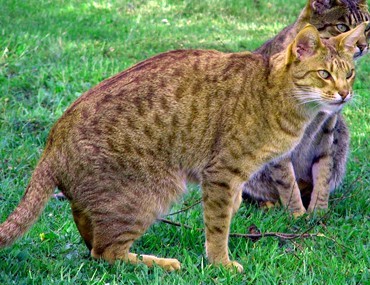History
The Ocicat may look wild and exotic, but he's anything but fierce. You’ll find few breeds friendlier, and the Ocicat’s majestic spots are a sight to see!
The Ocicat is a young breed, the result of a breeding project by a CFA breeder named Virginia Daly in 1964. Attempting to breed an Abyssinian-pointed Siamese, Daly watched as the first generation appeared as Abyssinian and the second generation produced a spotted kitten named Tonga. Tonga, nicknamed an “ocicat,” was neutered and sold, but further breedings of Tonga’s parents produced more spotted kittens. In the following years, some Siamese and American Shorthair breeds were entered into the mix and voila! The Ocicat was born!
An officially recognized breed in 1966, the Ocicat is one of the most popular cat breeds in the United States.
Cat Facts
The Ocicat is a pretty neat breed, and here’s why:
- They Ocicat comes in 3 basic colors that are expressed in 4 varieties, for a total of 12 recognized colors, including chocolate, silver, lavender, cinnamon, and blue.
- The Ocicat is covered in a regal pattern of quarter-sized spots shaped like bull’s-eyes
- Weight: 7-14 pounds
- Lifespan: 15-18 years
What are they like?
Defying cat stereotypes everywhere, the Ocicat the opposite of aloof and independent! He is a gregarious cat who loves pretty much everyone. Whether looking for a lap or trying to play a game, the Ocicat isn’t afraid to jump right in and introduce himself.
He’s great at making himself the center of attention. Highly intelligent, the Ocicat is also as physically active as he is mentally active, so he needs a lot of stimulation. Puzzling toys are as good, asis a game of fetch!
 Also, the Ocicat is fantastic with children, gets along great with other pets, and is adaptable enough to be a joy to travel with.
Also, the Ocicat is fantastic with children, gets along great with other pets, and is adaptable enough to be a joy to travel with.
The Ocicat is a relatively healthy breed of cat, but he does have some health issues that appear in the breeds that were mixed to make him:
- Renal amyloidosis, a kidney disease
- Pyruvate kinase disease, which can lead to anemia
- Hypertrophic cardiomyopathy, a form of heart disease
- Prone to gingivitis
Right for you?
Part of the allure of an Ocicat is his exotic appearance, and the other part is his great personality. But, as with all pets, there are always a few things to consider when welcoming a furry friend into your home. Here are some things to consider about the Ocicat:
- The Ocicat is single-coated, meaning he is better off indoors than out.
- The Ocicat’s coat needs very little grooming. Rubbing him down once a week with a chamois cloth to remove dead hairs should do the trick.
- The Ocicat’s love for attention and need for stimulation can make him a bit demanding at times. They don’t like to be alone for long, so if you work long hours or your family isn’t around much, it’s best to get a companion for an Ocicat.
- The Ocicat is prone to gingivitis, so he requires regular dental care. It can take some time to coax a cat into being comfortable having his teeth brushed, so you’ll have to be patient.
If you have any questions or concerns, you should always visit or call your veterinarian – they are your best resource to ensure the health and well-being of your pets.
